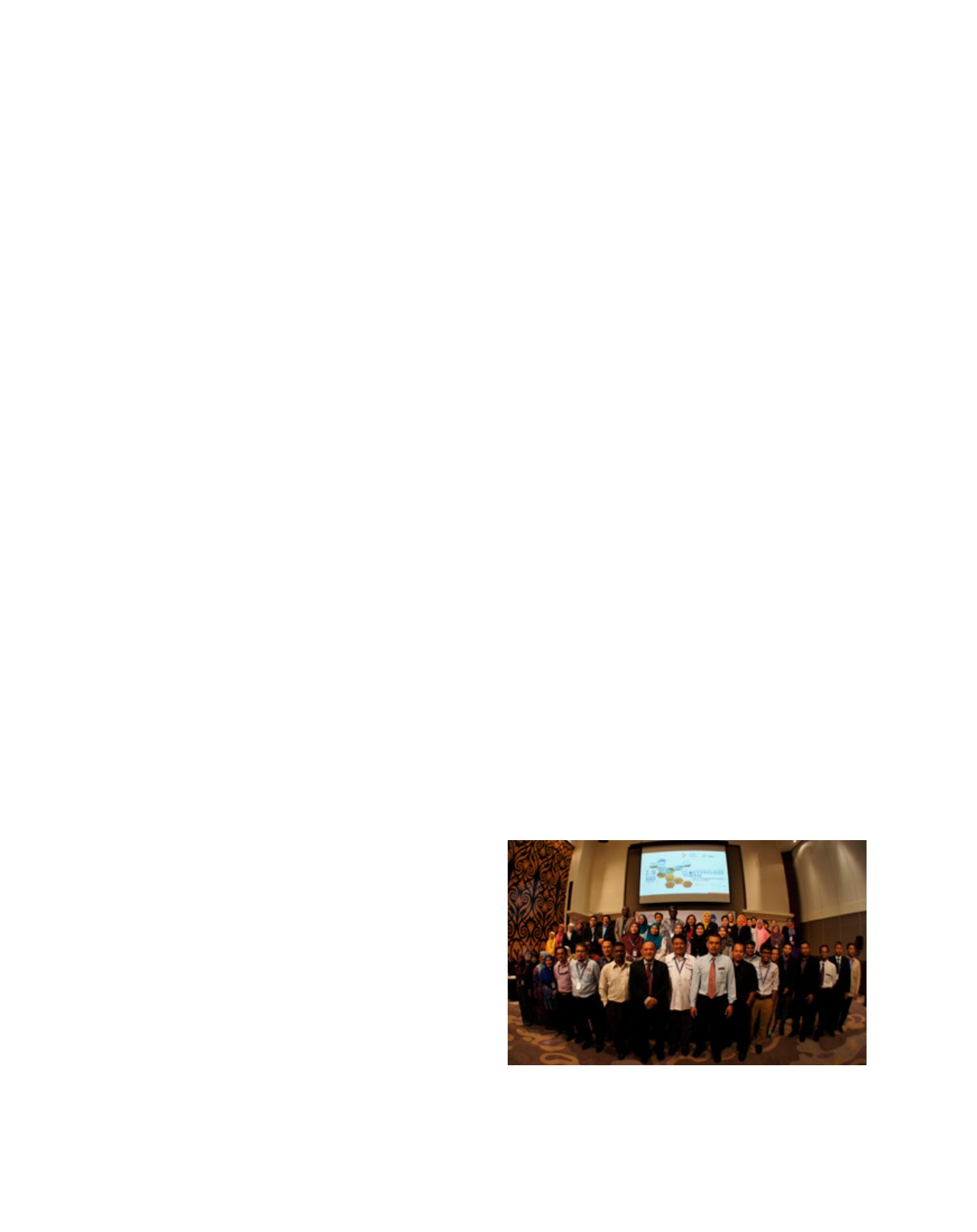

[
] 39
A B
et ter
W
or ld
tions and non-governmental organisations. These platforms
could be used to further refine alignment in managing water
resources and to gain first hand information from the devel-
oped countries for adoption in Malaysia.
Awareness and capacity building
Efforts to secure and sustain water resources as well as to
engage stakeholders requires continued focus. Working
together among stakeholders to nurture a sense of belong-
ing among communities is the key to achieving sustainable
results. This is captured in the MNWRP where capacity
building and awareness is one of the main concerns.
Good practical models introduced by the River of Life
(RoL)
3
project’s Public Outreach Program (POP) have
prepared the way for a new awareness platform in the Klang
Valley area. RoL and sewerage are water-related projects
given priority as high impact Entry Point Projects (EPPs) in
the Tenth Malaysia Plan which will enable Kuala Lumpur to
become a top twenty Most Livable City.
The Government Transformation Program (GTP) and
Economic Transformation Program (ETP) were created
to make Malaysia into a fully developed nation by 2020.
This EPP project spans four ministries: Ministry of Federal
Territory (KWP); Ministry of Energy, Green Technology and
Water (KETTHA); Ministry of Urban Wellbeing, Housing
and Local Government (KPKT); and Ministry of Natural
Resources and Environment (NRE).
There are ten key approaches in RoL POP, namely Smart
partnership; Integrated approach; Civic science approach;
Active consultation process; Pollution prevention at source;
Working with ongoing activities; Participatory and practi-
cal approach; Involving the mainstream and social media;
Stimulating stakeholder contributions and co-financing;
and Sustaining the activities beyond the project period (exit
strategy). These key approaches have created strategies that
reconnect six target groups – local communities; institutions;
industries; cooperation and developers; food establishments;
workshops and wet markets – with nature. The RoL POP
has been conducted over only 10.7% of the total RoL area of
551 km
2
, comprising RoL POP 1 – upper Sg Klang (40.4 km
2
)
– and RoL POP 2 – Sg Bunus catchment (18.3 km
2
). A case
study conducted by HTC KL and its partners concludes that
the annual average wet load of the Sg Kerayong catchment
(area without POP) is higher than that of Upper Sg Klang
(area with POP) due to the successful Public Outreach
Programme conducted at Sg Klang. The result is that the
difference in annual gross pollutant load between Upper
Sungai Klang and Sungai Kerayong catchment is around 57%.
As Malaysia celebrated 60 years as an independent nation
in 2017, the prime minister launched the 2050 National
Transformation (TN50) roadmap, which is an initiative to
plan for the future of the country, specifically in the period
2020 to 2050. In order to achieve the five TN50 “Circles of
the Future” – Work and value creation; Living and wellbeing;
Governance; Society; and Lifestyle – we need the diversity
and inclusiveness of all parties. Awareness and capacity
building will prioritise the promotion of urban gardening,
sustainable cities, accessible infrastructure and the reduction
of the carbon footprint.
To empower capacity building, DID has a succession plan
to expand knowledge and awareness of water security. This
follows the seminars, workshops, and training conducted
at national and international level in recent decades, i.e.
International Conference on Urban Drainage (ICUD); Asia
Water Resources Expo and Forum (AWARE); International
Conference on Water Resources; National Water Watch
Programme for Young Leaders; and a one-off capacity building
event curated by the DID. The network and linkage activi-
ties have included the 7th World Water Forum 2015; Joint
University of Canberra-UNESCO International Forum on
Sustainable Landscape; Inter-Regional Workshop on South-
South Cooperation for Upscaling Integrated Water Resources
Management and Ecohydrology as Tools for Achieving Water
Security in Africa; International Workshop on Capacity
Building of Journalist Educators on Climate Change and
Water Management using UNESCO Model Curricular in
Tehran; and The Workshop for Capacity Building on Climate
Change Impact Assessments and Adaptation Planning in the
Asia-Pacific Region, in Manila.
Conclusion
Sustainable development must be put in place now as a legacy.
Its future is fragile until the IWRM ambitions are met. In line
with the SDG theme “The Future We Want” as adopted in
the UN General Assembly Resolution 66/288 on 27th July
2012, all countries should work towards the achievement of
the sustainable development goals by 2030. The realisation
of these goals requires collective and collaborative partner-
ship efforts including resource mobilisation, innovation and
knowledge sharing, as well as active partnerships among the
government, private sector, non-governmental organisations,
civil society, universities and research institutions. Thus,
DID, with its enhancement of strategic collaboration and
networking, awareness, and a continuous succession plan for
capacity building, is on track to support SDG 6, particularly
theme 6.6a: Expand international cooperation and capacity-
building, and theme 6.6b: Support and strengthening of
participation of local communities in improving water and
sanitation management.
Image: DID, Malaysia
The International Workshop on Comparative Studies of Applying
Ecohydrology and Integrated Water Resources Management for Upscaling
Water Security in Asia and Africa, organised through UNESCO Water Centre
Category 2, Kuala Lumpur, 2016
















